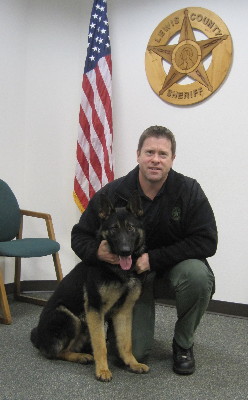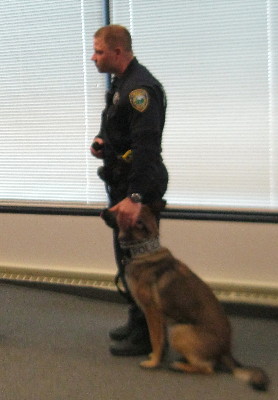By Sharyn L. Decker
Lewis County Sirens news reporter
CHEHALIS – Two new police dogs joined local police agencies after passing their accreditation tests last week.
The Chehalis Police Department now has a canine to call its own, with 19-month-old Reign partnering with Officer Warren Ayers.
The German Shepherd and Malinois mix was introduced this evening to the city council.
He worked his first shift this weekend, helping try to track a subject in Thurston County, Ayers said.
The animals’ basic training consisted of 400 hours over three months.
At the Lewis County Sheriff’s Office, 15-month-old Axel is now qualified to work patrol with his handler Deputy Rick Vanwyck.
The sheriff’s office said the German Shepherd in the near future will be cross trained for narcotics detection.
Both the new dogs are from the Czech Republic and both are trained to track and apprehend people and evidence.
Sheriff Steve Mansfield, in a news release, praised Centralia Police Department Officer Tracy Murphy for assisting to select the right dog, which he called another excellent tool to help combat crime in Lewis County.
Tags: By Sharyn L. Decker, news reporter


This dog is also going to be a patrol dog meaning he can chase down bad guys. Many times chases or building searches can be terminated quickly just by the four legged partner barking. I
Thank you Clear Understanding for educating those who have NOT been through the intense training that one is REQUIRED to attend and REQUIRED to pass certification as K9 Team.
I too am a former K9 handler. Soaper and others need to understand that we don’t just get a dog and hit the streets. A patrol K9 team is required to do more than 400 hours of training and a narcotics K9 team is required to do 200 hours of training. (WAC 139.05.915 look it up Soaper).
Part of our training is studying case law (federal and state) and to the legal uses of an application of a K9 sniff. US vs Place determined that a K9 sniff is NOT a search. There is NO expectation of privacy in contraband. A K9’s alert can be the SOLE probable cause to search or to obtain a search warrant. Bear in mind Soaper, that a judge reviews the K9 handler’s application (affidavit) for a search warrant. This will include the K9’s training, the handler’s training and detailed information about the alert. And much more information. My K9 search warrant application was 3 pages long. We were granted MANY search warrant based on my K9 partner’s alert. And we had MANY drug finds on those search warrants.
We also conduct regular maintenance training to verify that the dog and handler’s accuracy as a K9 team. Very strict records are kept during initial training, maintenance training and actual searches.
So, I hope this ads a little more clarity to what Clear Understanding wrote.
A trained/experienced handler can easily tell when a dog is on odor. There are three phases to an alert…in order…1) change of breathing 2) change in body posture 3) the physical indication (sit, down, scratch). To add too your confusion an ‘adverse’ response can also be PC (probable cause) the same as an alert.
Having been through police k9 handler school AND police k9 instructor school, I can assure you that you have been handed a truck load of misinformation. I trained with handlers/trainers from THP and their dogs while in instructor school. If that was the info you got, it was from somebody pulling your chain or a rogue one. THAT was NOT my experience at all.
Bad handling/deployment of K9’s makes for bad case law and pissy DOJ, which the vast majority try to avoid at all cost.
The indication (sit, down, scratch) is taught as an ‘understanding’ communication of finite commitment to the task at hand to where the newbie at the other end of the leash ‘gets’ it. It is not the end all be all. A good handler knows when his dog is on odor well before the indication happens. Just like a good handler knows his bird dog is on odor well before the point.Just because somebody has no clue cannot tell, does not mean an alert is not there. The indication is just for show once you know how to read a dog.
Hope this blesses you with a little clarity.
OK, so if they are going to have dogs then there needs to be a clear understanding of what exact behavior the dog shows when it “hits” on something. There have been so many times where the dog doesn’t do anything and the handler goes “oh ya that’s a hit” and proceeds to tear through the vehicle in question. I’ve heard of Centralia actually getting the dogs toy out and rubbing it on the vehicle to make the dog “hit.” Sometimes if the dog sits down “oh theres a hit” or if he scratches “oh, look at that, he is hitting on it.”
Having a dog makes it to where they can get into your vehicle without proper probable cause because they claim that the K-9 isn’t performing a search. OK then what is it doing? It is using it’s primary sense to seek something out. Yet, somehow that isn’t considered a search? It’s not like the dog can testify in a courtroom.
Finally, a former Texas Highway Patrolman who used to train these animals said that many of them are trained to “false alert.” Meaning the handler can make a subtle noise or action and the dog will hit on whatever the handler wants it to. The whole thing is foul.